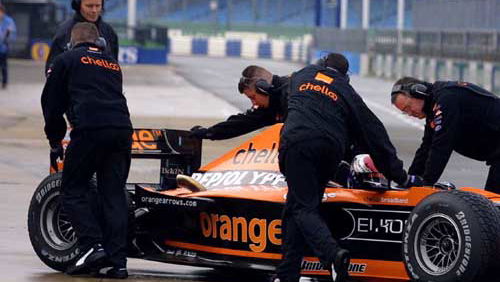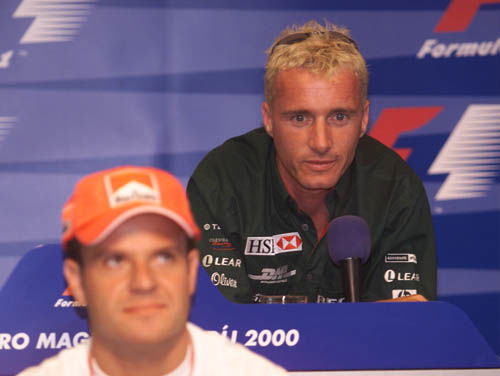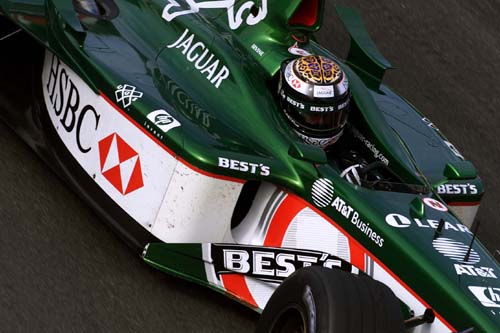Formula One: A mechanic's tale.
Formula One is not just about the glamour of Monaco, the millionaire racing drivers, the grid girls and glitzy parties - at the heart of the sport are the mechanics who work long hours in difficult conditions to make sure the cars make it to the track on time.

Formula One is not just about the glamour of Monaco, the millionaire racing drivers, the grid girls and glitzy parties - at the heart of the sport are the mechanics who work long hours in difficult conditions to make sure the cars make it to the track on time.
Greg Baker's childhood dream was to be one of those mechanics, working in Formula One and now, as number one mechanic on Jos Verstappen's car at Arrows, he has fulfilled his dream. Each F1 team has only three number ones and, with only eleven teams in the world, Greg is one of an elite band of specialists. He is one of the men who makes sure that the car is set-up to the driver's specification and that it is ready to go when the lights go green.
Greg's path to Formula One began at the age of 17, when he embarked on a five-year mechanic's apprenticeship whilst working in a garage in his home county of Cheshire. Now 34, Greg has worked his way up through the ranks. In 1990, he began a two-year stint with TWR Group - the parent company of OrangeArrows - working as a number two mechanic for Jaguar Group C sportscars. During this time, the team won the World Sports Car Championship and Le Mans 24 hour race, a result which made Greg feel immensely proud.
In 1992, he moved to Prodrive Engineering for two years, then moved on again to Schubel Engineering for a further season before joining the Williams touring car team in 1995. Greg was number one mechanic on double champion Alain Menu's car, something he regards as a fantastic challenge but, all the time, Formula One was still calling him.
Four years ago, Greg finally got his break in Formula One. Returning to TWR Group, he began work for the OrangeArrows team, initially as a test team mechanic, and then moved to the race team where he was the 'front end' mechanic on Damon Hill's car for one season. Promoted to number one mechanic for Mika Salo in '98 and Tora Takagi in '99, he is now number one for Jos Verstappen.
But what does a number one mechanic actually do?
As number one, Greg is the head mechanic responsible for that one car, overseeing exactly what is going on, ensuring the car's set-up is at the right specifications and that each of the other mechanics in his car crew know exactly what needs to be done.
The structure of the race team's engineering in quite standard, with a technical director at the top - at OrangeArrows this is Mike Coughlan - a chief race engineer (Graham Taylor), and then two race engineers - Greg Wheeler on Verstappen's car and Stefano Sordo on Enrique Bernoldi's. A chief mechanic, Stuart Cowie, oversees all three cars.
Greg Wheeler will talk to Greg Baker with any issues concerning Verstappen's car, which he then filters to his car crew. Bernoldi's car crew, and that of the T-car, all have the same procedure. The flow of information doesn't necessarily start from the top though, as everybody on the team participates in discussions regarding their car which creates a great sense of involvement which helps to motivate the crew.
As a member of the OrangeArrows race team, Greg's job involves a great deal of international travel. Following a typical European race, the team fly home on Monday morning and Greg has just enough time to re-introduce himself to his family before he heads off to the factory to prepare his car for the next grand prix.
The cars usually arrive back at Leafield on the Tuesday after the race and responsibility for Verstappen's car is handed to Greg. The car is then stripped down by it's race crew, the chassis sent off to be repainted, and all the other components go off to the relevant departments to be stripped, re-built, checked and re-assembled. The cars come back from the paint shop on Wednesday morning as they are sprayed overnight, and Greg and his crew spend Wednesday and Thursday re-building the cars before firing them up on Friday to make sure the engine, gearbox and electronics are all working correctly. The car is then set-up as accurately as possible for the next race, with the set-up being determined by the tracks characteristics, for example whether it is a high or low downforce circuit, results from previous testing data and rig circuit simulation.
The trucks leave on Sunday with the cars and all the equipment required for the following weekend, and the team arrive at the circuit on Wednesday.
Once at the track, the mechanics help with the last bits of unpacking and setting up the garage, as the race set-up truck crew will have done the majority of it.
The race weekend really starts at 8am on Thursday and the best person to tell the story is the man himself....
Thursday
''We are all up bright and early on Thursday as we have to get down to the track to check absolutely everything. Me and my crew will make any alterations to the cars' set-ups that the engineers may think necessary, fire the engines up and check the gearboxes, along with the telemetry, to avoid any last minute problems. As long as there are no problems, we can get away from the track in good time to go and visit a local restaurant, but we have to make sure we get enough sleep as it's an early start tomorrow.''
Friday
''When I said an early start I wasn't joking! We arrive at the circuit at around 7am and prepare for the two practice sessions from 11 -12am and 1-2pm. We stop work briefly at 8am for the most important meal of the day - breakfast! And I mean sausage, eggs, bacon, toast - the lot! The F1 caterers have one of the most important, and thankless, jobs in Formula One, but us 'bolties' couldn't do it without them. I should explain that 'boltie' is an affectionate name for the F1 mechanics. It quite simply means that we bolt parts onto the car, although we all know there's more to it than that.
''Between sessions, car set-up changes are inevitable as Jos and Enrique say how they think the car could be altered in certain areas to improve performance in the second session.
''After the sessions, the gearboxes are removed and gear ratios checked, the hydraulics examined, front end of the car stripped, and new brakes fitted, front and rear. All three cars then have to go to the FIA scales to be weighed and checked against FIA regulations, and when you are allowed 15 minutes per car and there are other teams queuing in front of you it can take a long time.... Friday's are usually about a 10.30pm finish. Just enough time for a quick beer in the bar and a lively discussion about the day's events on the track and the usual off-track gossip before its time for bed.''
Saturday
''We all share rooms in hotels. Sometimes you want a bit of privacy, but we all get on well and it certainly helps to be sharing with a mate when you oversleep in the morning! Nobody wants that bang on the door that tells them their oversleeping is keeping the rest of the team waiting!
''We get to the track at 6.30am on Saturday as the practice sessions are earlier in the day from 9.00-9.45am and 10.15-11a.m. After breakfast and a few friendly jibes at the marketing team, who never have to be there as early as us, we get on with practice which is a pretty similar procedure to yesterday's sessions.
''At 11am, we remove the engine and gearbox and fit a 'qualifying' engine and gearbox, only used for the qualifying session later that day, change the brakes, go back to FIA scales to weigh and check the car again and make any set-up or suspension changes needed. Remember, we only have two hours between the end of practice and qualifying to do this so you can feel quite pressurised. After an hour of qualifying at 2pm, we change the engine and gearbox to a 'race' engine and gearbox, change all brakes, check the fuel cell, fit various components for the race, make final checks to the whole car, go back to the FIA scales and finish hopefully about midnight!''
Sunday - race day
''It's another early start on Sunday, as there is a 30-minute warm up session in the morning, which always ends four hours before the start of the race, so the time will vary slightly as some races start at 1pm and some at 2pm. If there is a likelihood that it may rain during the race, which last season was very often, then we have to try a couple of different car set-ups during warm-up for dry and wet conditions, so, with only half an hour, you need to work very fast!
''The T-car, that's what we call the spare car, will be set-up for whichever driver qualified higher, so he will go out in it for an 'installation lap' at the beginning of warm-up, which is the first time the T-car is allowed to run during the weekend. This is to make sure all the systems are functioning properly and then he will get out and jump into his race car. From then on, any changes that are made to the race car of the higher qualifier, are made to the T-car by the T-car crew so the cars are identical.
''The next three and a half hours are spent getting the car ready for the race, with the pit-lane opening half an hour before the start of the race, at which time the cars can then go out. They have to come through the pit-lane to complete a lap, otherwise, go straight to the grid where they will then stay until the start of the race. Jos normally goes out and comes back thorough the pit-lane once just to confirm that the car is okay, but this is also our last chance to make any alterations to the car if necessary before he goes out to take his place on the grid. The pit-lane closes 15 minutes before the start of the race, and if a car is not on the grid by this point, then it has to start the race from the pit-lane after all the other cars have left the grid. It can be pretty frantic if any problems are found at this stage!
''Each car crew, Enrique's and ours, then make their way onto the grid for final car checks and to fit the first set of race tyres. With 15 seconds to go, the race crew must be away from the car and we all stand at the edge of the track for the formation lap. At this point, I'm just hoping that the car pulls away alright and there are no problems, otherwise we have to run back out and re-start the car. Running to and from the grid can often involve having to jump over the pit-wall with all the grid equipment, so that can be awkward! This is more of a problem in Monaco than anywhere else as the wall is pretty high!
''The cars then reform on the grid after the formation lap, and away they go for the race. This is when we have to run back to the garage with the grid trolley, tyres, fans, batteries, computers and loads of other equipment and get ready for the pit-stops.
''The pit-stops are planned as part of the race strategy, but these can change if the weather changes or there is a problem with a car. Generally though, we know about 40 seconds before a pit-stop what needs to be done - tyres, fuel, or change the front nose cone for example - which can take between six and eleven seconds anywhere from one to possibly eight times a race!
''After the race, we all help to pack up which we can usually do in four hours. Then it's either back to the hotel or a mad dash to the airport to catch the last flight out of the country.
''This cycle continues throughout the eight-month season but, although it may seem repetitive, the crews all know it is the best way to work. It's what teamwork is all about. Everyone in the team, and therefore each car crew, has very specific tasks but, if something needs to be altered on the car, then one person automatically knows it is their responsibility and does it without needing to be told. It makes working much faster and more consistent. Also, each race, circuit and country are very different in their own ways, so there is actually quite a lot of variety in the mechanics' work.''
Verstappen is highly appreciative of his number one, and knows that it is important to have a good relationship with Greg.
''Greg has the responsibility for my car, and keeps an eye on everything that is going on,'' the Dutchman comments, ''He is very serious about his job, very good at what he does and knows how to get the best from the mechanics in my car crew. I like him very much as a person too, and am very happy to put my trust in him to make sure my car goes well and also look after my safety.''
''I love it, it's a great life,'' Greg admits, ''Arrows is a good team and that's a big part of it, the camaraderie of a team and spending the time with your colleagues who are also your mates. It can get a bit tense at times, when time is very tight or towards the end of the season when everybody is getting tired, but not many people can say that they really enjoy what they do. It's a great environment to work in and there are opportunities out there for aspiring mechanics. I can thoroughly recommend it!!''

